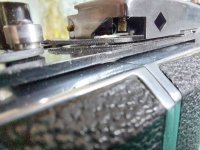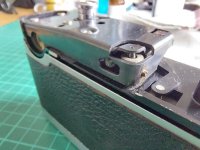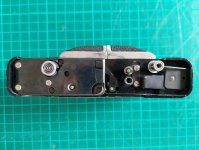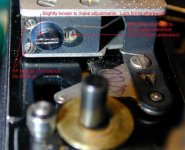I downloaded this a long time ago, This is the worst designed adjustment for a Rangefinder mechanism that I have ever dealt with. The Prominent is 2nd worst. Voigtlander made great lenses. The cameras themselves are not well thought out, and beautifully made. The phrase is "What idiot designed this!"
========================================================================================
Downloaded almost 20 years ago:
Barn-Doors Voigtlander Vitessa N. Circa 1954.
Adjusting Rangefinder.
by
Stuart Willis
The adjustment comes in two parts. First adjust the prism (3 screws plus a central locking screw). The adjustments here are so fine that it is almost impossible to get the horizontal RF coincidence exact. The fine tuning is then done by adjusting the swinging beam-splitter. (See Pix).
RF adjustment is made extremely tedious by the thoughtless design. There are no access ports via the camera's top plate. With the top-plate removed one needs to set the focus at infinity for adjustments. But the focusing wheel blocks access to the prism adjustment screws. There is worse to come. The eyepiece and exit-pupil optics are integral with the top plate and thus one cannot view rangefinder performance unless the top plate is refitted.
It is clear that there is a special factory tool which one just drops over the viewfinder - and which incorporates eyepiece and exit-pupil optics. With such a tool, the factory (or suitably equipped service lab') can easily adjust the rangefinder when the top plate is removed.
Lesser equipped mortals must reinstall the top-plate and focusing wheel and check the results after each fine tweak.
When first removing the top plate you doubtless think your "Vitessa N" has been misassembled by some previous incompetent deisel mechanic. However, the tilted viewfinder/rangerfinder module is made like this.
Supplementary Note:
The shutter cocking / film advance wind plunger on these Vitessas is prone to knocks and abuse. Any "rock" will have its fulcrum at the top - and given the long moment, when the lens block is at full extension for closest focus, even 0.015 of play will transpose into "slop" at the other end as sufficient to overshoot the shutter cocking latch which is only 1mm thick.
The telltale symptom of this is that after a close-focus shot the plunger may not fully return. This leavesyou with a jammed camera.
Even though I brass shimmed the plunger, I found it necessary to limit the maximum lens block extension to a closest focus point of 4ft.
This was accomplished by adding an 0.020" thick brass washer beneath the focusing wheel. As can be seen from the Pic - that washer by its carefully chosen diameter, prevents rangefinder cam from fully returning. Indeed - the brass washer was hand made for the job.
The alternative to such modification is a complete strip out of the barns doors, lens block assembly and the plunger mechanism. A very complicated procedure to be followed by some precision re-engineering of worn components. Shimming of the plunger and incorporation of the brass washer as with its inherent loss of 6 inches of close focus, was thus a most acceptable course.
















